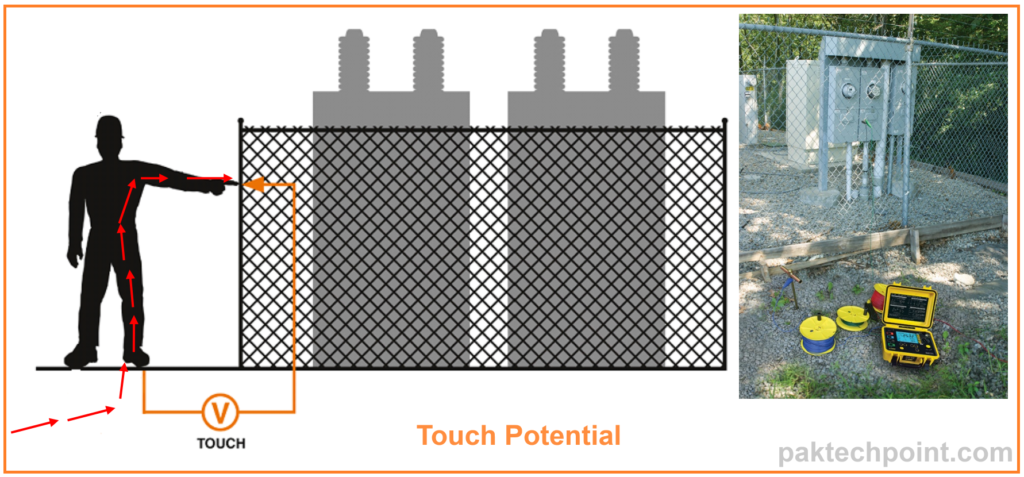Touch Potential (TP) is an electrical engineering and safety concept used to describe the difference in voltage (potential difference) between two points on a conductive object when one person touches them simultaneously, providing an important way of evaluating electrical systems and equipment for safety in environments where electrical faults may be possible.
Touch Potential refers to the voltage experienced when touching two surfaces or parts of an object with different electrical potentials, and this difference could present an electric shock risk if it exceeds safe thresholds.

Touch Potential is an integral factor of electrical safety standards and regulations, helping determine the appropriate precautions and insulation requirements needed to prevent electric shock hazards. Touch Potential thresholds tend to be much lower than Step Potential thresholds which assess voltage variations when taking steps in areas with differing ground potentials.
What is Touch Potential (TP)?
Touch Potential refers to the voltage difference experienced by a person when they touch two different conductive surfaces or objects that have varying electrical potentials. One of these surfaces is typically grounded, while the other may not be, creating a potential for electric shock.
Touch Potential represents an electrical hazard, as it involves the risk of electric shock. When a person touches two surfaces with differing potentials and completes an electrical circuit through their body, they can be exposed to dangerous levels of electricity.
In Touch Potential scenarios, the electrical currents flow through and around the person’s body, including the heart. This is a significant concern because electrical currents passing through the heart can disrupt its normal rhythm and potentially lead to cardiac arrest.
To mitigate the risk of Touch Potential hazards, safety measures are crucial. These measures may include proper grounding of equipment and structures, maintaining insulation and electrical systems, and ensuring that personnel are trained in electrical safety protocols.
Touch Potential thresholds are typically defined by safety standards and regulations to establish safe limits for potential differences that individuals may encounter. These standards help protect workers and the general public in environments with electrical equipment and systems.
Touch Potential Test Procedure:
A Touch Potential Test is a crucial procedure in electrical safety to evaluate the risk of electric shock when a person touches different conductive surfaces with varying electrical potentials. Here’s a step-by-step guide on how to perform this test effectively:
Equipment Needed:
- Metal object that would be touched (e.g., equipment, structure).
- Grounding system with E and Es leads.
- Two electrodes: one approximately 1 meter (3 feet) away from the object and the other at the expected fault location.
- Test leads (S and H leads).
- 4-pole Ground Resistance Tester.
Step-by-Step Procedure:
1. Connect the E and Es Leads:
- Start by connecting the E lead to the metal object that would be touched.
- Connect the Es lead to the same metal object. These leads will be used as reference points.
2. Position the Electrodes:
- Insert one electrode approximately 1 meter (3 feet) away from the metal object.
- Connect the S lead from the Ground Resistance Tester to this electrode.
- Insert the other electrode at the expected location of the fault.
- Connect the H lead from the Ground Resistance Tester to this second electrode.
3. Start the Test:
- Activate the 4-point Ground Test Mode on your Ground Resistance Tester.
- Begin the test and record the resistance reading provided by the tester.
4. Calculate Touch Potential Voltage:
- Estimate the expected fault current (I). This value may vary depending on specific circumstances and the nature of the electrical environment.
- Multiply the estimated fault current (I) by the resistance reading (R) obtained from the test to calculate the touch potential voltage (V).
- The formula is: V = I * R.
Example Calculation:
- Resistance reading (R) = 0.2Ω.
- Estimated fault current (I) = 1000 Amps.
- Touch potential voltage (V) = R * I = 0.2 * 1000 = 200 Volts.
By following this Touch Potential Test procedure, you can assess the potential voltage difference that a person might experience when touching different conductive surfaces. This information is essential for evaluating the safety of personnel working in electrical environments and for ensuring that safety measures are in place to prevent electric shock hazards.
Read Also: What is Step Potential? Step Potential Test Procedure.